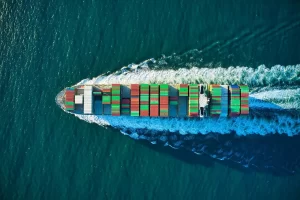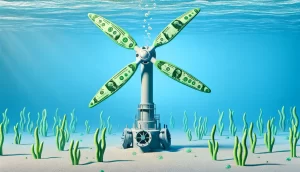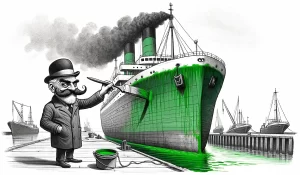President Biden will soon sign into law the Infrastructure Investment and Jobs Act which makes available hundreds of billions of dollars for infrastructure projects throughout the country. I combed through the bill to highlight all of the maritime decarbonization relevant bits and was surprised how much I found, especially for ports and ferries. By my estimates, this Bill will make approximately $17 billion worth of funding available to the domestic maritime sector over the next five years. Let’s get to work!
Note that I’ve condensed sections of this bill quite a bit and made changes for the sake of brevity, see original Bill language for exact wording.
Department of Transportation
SEC. 11110. NATIONALLY SIGNIFICANT FREIGHT AND HIGHWAY PROJECTS
Section 117 of title 23, United States Code, was amended to include projects for a marine highway corridors as designated by the Secretary of Transportation. Each grant made under this section shall be in an amount that is at least $25,000,000 and the bill provides $3.2 billion to carry out the program.
SEC. 11114. NATIONAL HIGHWAY FREIGHT PROGRAM
Section 167 of title 23, United States Code, is amended by adding projects related to a marine highway corridor, connector, or crossing as designated by the Secretary of Transport.
SEC. 11115. CONGESTION MITIGATION AND AIR QUALITY IMPROVEMENT PROGRAM
Section 149 of title 23 is amended to include projects on a marine highway corridor, connector, or crossing designated by the Secretary of Transportation. The congestion mitigation and air quality improvement program provides approximately $2.5 billion each year to all the States
SEC. 11116. ALASKA HIGHWAY
Section 218 of title 23 is amended allowing the Secretary of Transport to expend Alaska Marine Highway System any Federal-aid highway funds apportioned to the State of Alaska under this title. For purposes of this section, the term ‘Alaska Marine Highway System’ includes all existing or planned transportation facilities and equipment in Alaska, including the lease, purchase, or construction of vessels, terminals, docks, floats, ramps, staging areas, parking lots, bridges, and approaches thereto, and necessary roads
SEC. 11117. TOLL ROADS, BRIDGES, TUNNELS, AND FERRIES
Section 129(c) of title 23, is amended in the matter preceding paragraph (1) by striking ‘‘the construction of ferry boats and ferry terminal facilities, whether toll or free,’’ and inserting ‘‘the construction of ferry boats and ferry terminal facilities (including ferry maintenance facilities), whether toll or free, and the procurement of transit vehicles used exclusively as an integral part of an intermodal ferry trip.” For diesel fuel ferry vessels, the percent of a project’s cost covered by the government went up to 85%.
SEC. 11402 REDUCTION OF TRUCK EMISSIONS AT PORT FACILITIES
This establishes a new program within the Department of Transportation to reduce idling at port facilities. The program has three directives:
- study how ports and intermodal port transfer facilities would benefit from increased opportunities to reduce emissions at ports, including through the electrification of port operations;
- study emerging technologies and strategies that may help reduce port-related emissions from idling trucks; and
- coordinate and provide funding to test, evaluate, and deploy projects that reduce port-related emissions from idling trucks, including through the advancement of port electrification and improvements in efficiency, focusing on port operations, including heavy-duty commercial vehicles, and other related projects.
Further, the DOT is directed to award grants to projects that reduce emissions at ports, including through the advancement of port electrification. $150,000,000 is provided through 2026 for this program.
SEC. 11403. CARBON REDUCTION PROGRAM
This establishes a new carbon reduction program to reduce transportation emissions. The term ‘transportation emissions’ means carbon dioxide emissions from on-road highway sources of those emissions within a State. Eligible projects to be funded under this new program include:
- a project or strategy that is designed to support congestion pricing, shifting transportation demand to nonpeak hours or other transportation modes…;
- efforts to reduce the environmental and community impacts of freight movement;
- a project to support deployment of alternative fuel vehicles, including the acquisition, installation, or operation of publicly accessible electric vehicle charging infrastructure or hydrogen, natural gas, or propane vehicle fueling infrastructure; and
- a project that reduces transportation emissions at port facilities, including through the advancement of port electrification
SEC. 21202. LOCAL AND REGIONAL PROJECT ASSISTANCE
Chapter 67 of subtitle III of title 49 is amended by adding a new ‘Local and Regional Project Assistance Program’, to provide for capital investments in surface transportation infrastructure projects that will have a significant local or regional impact. Eligible projects include port infrastructure investment, including inland port infrastructure and a land port-of-entry. Grants under this new program are at least $5 million for urbanized areas and between $1 million and $25 million for rural areas.
SEC. 25012. ADVANCED TRANSPORTATION RESEARCH
This section establishes within the Department of Transport an agency to be named ‘Advanced Research Projects Agency–Infrastructure’ to support the development of science and technology solutions for infrastructure projects. This is a similar model to DARPA and ARPA-E, but where as those focus on defense projects and clean energy respectively, this one will focus on infrastructure. The goals of ARPA-I are to advance the transportation infrastructure of the United States by developing innovative science and technology solutions that:
- lower the long-term costs of infrastructure development, including costs of planning, construction, and maintenance;
- reduce the lifecycle impacts of transportation infrastructure on the environment, including through the reduction of greenhouse gas emissions
- contribute significantly to improving the safe, secure, and efficient movement of goods and people; and
- promote the resilience of infrastructure from physical and cyber threats.
ARPA-I will be able to provide grants, contracts, cooperative agreement, cash prizes, or other similar forms of funding.
SEC. 71102. ELECTRIC OR LOW-EMITTING FERRY PILOT PROGRAM
This establishes a new pilot program to provide grants for the purchase of electric or low-emitting ferries and the electrification of or other reduction of emissions from existing ferries. It does mention two stipulations:
- at least one grant shall be for a ferry service that serves the State with the largest number of Marine Highway System miles; and
- at least one grant shall be for a bi-State ferry service with an aging fleet and whose development of zero and low emission power source ferries will propose to advance the state of the technology toward increasing the range and capacity of zero emission power source ferries.
For these competitive grants $250 million is made available, split up into $50 million chunks each fiscal year out through 2026.
SEC. 71103. FERRY SERVICE FOR RURAL COMMUNITIES
This establishes a new program to ensure that basic essential ferry service is provided to rural areas by providing funds to States to provide scheduled ferry transportation service. The program will provide funding to the States to fund projects that help develop ferry service between rural areas that are at least 50 miles apart. $200 million is authorized for this program each fiscal year through 2026.
PORT INFRASTRUCTURE DEVELOPMENT PROGRAM
This is an ongoing program that is seeing a large injection of funding and an increase in project eligibility. $2.25 billion is being provided to this program through September 30, 2036, portioned out in allotments of approximately $450 million each fiscal year. Projects already eligible for awards will now also include projects that improve the resiliency of ports to address sea-level rise, flooding, extreme weather events, earthquakes, and tsunami inundation, as well as projects that reduce or eliminate port-related criteria pollutant or greenhouse gas emissions, including projects for:
- Port electrification or electrification master planning;
- Harbor craft or equipment replacements/retrofits;
- Development of port or terminal micro-grids;
- Providing idling reduction infrastructure;
- Purchase of cargo handling equipment and related infrastructure;
- Worker training to support electrification technology;
- Installation of port bunkering facilities from ocean-going vessels for fuels;
- Electric vehicle charge or hydrogen refueling infrastructure for drayage, and medium or heavy duty trucks and locomotives that service the port and related grid upgrades; or
- Other related to port activities including charging infrastructure, electric rubber-tired gantry cranes, and anti-idling technologies:
FEDERAL HIGHWAY ADMINISTRATION HIGHWAY INFRASTRUCTURE PROGRAM
This program is amended, and within the increase in activity scope there are a few maritime related pieces. First, the amendments call for establishment of a Joint Office of Energy and Transportation in the Department of Transportation and the Department of Energy to study, plan, coordinate, and implement issues of joint concern between the two agencies. The Joint Office remit is fairly broad, but includes things like technical assistance related to the deployment, operation, and maintenance of zero emission vehicle charging and refueling infrastructure, renewable energy generation, vehicle-to-grid integration, including microgrids, and related programs and policies.
The amendments also make available $342 million each fiscal year through 2026 to carry out the Construction of Ferry Boats and Ferry Terminal Facilities program under section 147 of title 23.
Department of Energy
SEC. 40209. ADVANCED ENERGY MANUFACTURING AND RECYCLING GRANT PROGRAM
Within six months of President Biden signing this Act into law, the Secretary of Energy shall establish a new program to award grants for projects related to energy manufacturing or recycling. Eligible projects include those that:
- re-equips, expands, or establishes a manufacturing or recycling facility for the production or recycling, as applicable, of advanced energy property; or
- re-equips an industrial or manufacturing facility with equipment designed to reduce the greenhouse gas emissions of that facility substantially below the greenhouse gas emissions under current best practices, as determined by the Secretary,
Where advanced energy property explicitly includes light-, medium-, or heavy-duty electric or fuel cell vehicles, electric or fuel cell locomotives, electric or fuel cell maritime vessels, or electric or fuel cell planes. Or technologies, components, materials, and charging and refueling infrastructure of the same vehicles, locomotives, maritime vessels, or planes.
$750 million is made available for this new program, spread out evenly over the next five fiscal years.
SEC. 40313. CLEAN HYDROGEN RESEARCH AND DEVELOPMENT PROGRAM
This program is amended and its scope is broaden significantly, to include funding projects on:
- the safe and efficient delivery of hydrogen or hydrogen-carrier fuels, including convenient and economic refueling of maritime vessels at central refueling stations or through distributed onsite generation;
- advanced maritime vessel technologies, including: engine and emission control systems; energy storage, electric propulsion, and hybrid systems; maritime vessel materials; and other advanced maritime vessel technologies
- the use of clean hydrogen in the transportation sector, including in light-, medium-, and heavy-duty vehicles, rail transport, aviation, and maritime applications.
SEC. 40314. ADDITIONAL CLEAN HYDROGEN PROGRAMS
This establishes a new Regional Clean Hydrogen Hubs program to support the development of at least four hydrogen hubs that are diversified in terms of feedstocks, end-use applications, and regions. Ports, due to their intermodal aspect, are well-positioned to serve as one of these hubs. $8 billion has been dedicated to creation and operation of these hubs over the next five fiscal years.
SEC. 40401. DEPARTMENT OF ENERGY LOAN PROGRAMS
This amends the Advanced Technology Vehicle Manufacturing program within the Department of Energy’s Loan Program office to give them ability to help finance maritime vessel construction. This is a big deal and gives the Department of Energy some skin in the shipbuilding game.
SEC. 41201. OFFICE OF CLEAN ENERGY DEMONSTRATIONS
This establishes a new office within the Department of Energy that will provide grants for large demonstration projects. This office has been seeded with generous funding, almost $21.5 billion, but this money has already been portioned out to ten different project areas which include carbon capture, advanced nuclear reactors, energy storage, the Regional Clean Hydrogen Hubs (see above), electric grid reliability, and energy improvement in rural and remote areas. No explicit maritime call-outs in this, but there is a broad enough scope where maritime activities could be included.




